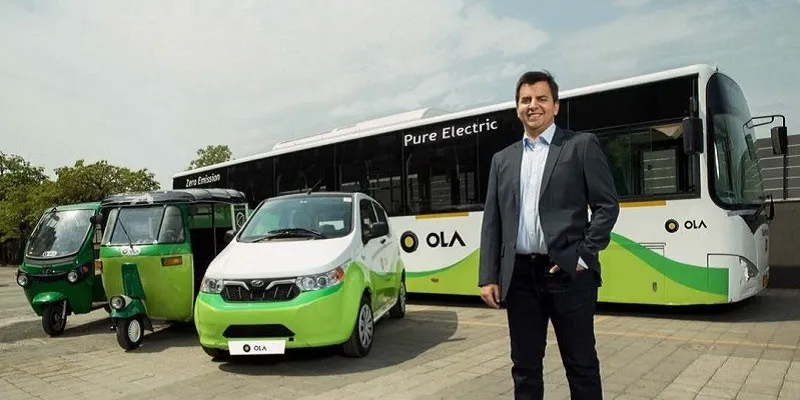Governments and startups must work closely to be EV-ready by 2022: Ola Mobility Report
Ola Electric, ride hailing unicorn Ola’s EV entity, has published a report in collaboration with the World Economic Forum. The report suggests building a strong value chain to ensure adoption of e-mobility, and focuses on the challenges faced by the sector.
Ola Electric’s Ola Mobility Institute, along with the World Economic Forum, has come up with a report with an analysis of the EV policies across different states in India. Following the government’s push towards making electric vehicles mainstream in India, different states have come up with their own policies for EVs.
The report calls for a common framework to bring in consistency and accelerate EV adoption in India.

Bhavish Aggarwal, Co-founder, Ola
In the report, Christopher Wolff, Head of Mobility Industries and Systems Initiatives, World Economic Forum, says:
“Using a value-chain framework to review all 10 states’ draft or final EV policies, this report allows for policymakers, businesses, and practitioners alike to highlight focal point policies and identify new opportunities for public-private collaboration. The analysis should continue to be developed further to provide recommendations to states on the sustainability and longevity of different EV policies.”
Anand Shah, Co-founder, Ola Electric, and Senior VP, Ola, explains the report had varied findings, including Bihar’s efforts to convert all pedal rickshaws to e-rickshaws by 2022, Karnataka’s focus on a venture capital fund for e-mobility startups, and Delhi’s efforts towards 50 percent e-buses in public transportation by 2023.
Help create a value chain
The report reveals the need to build a strong value chain to ensure adoption of e-mobility:
- Components of EVS such as batteries
- The charging infrastructure
- The network value chain
The report adds that this value-chain approach is needed while looking at policies.
It also focuses on the challenges the sector faces:
- The uptake of electric vehicles is slow because the vehicles are expensive, not only upfront but also on a life-cycle cost basis, or in other words, total cost of ownership (TCO).
- Electric vehicle ownership is disproportionately concentrated among high-income households and communities.
- The lack of robust fast-charging infrastructure, causing range anxiety among users, credit constraints, the limited choice set of vehicle models, and well-established behavioural failures that inhibit adoption of efficient technologies with lower life-cycle cost impede EV adoption.
To overcome these challenges the report suggests the strategy should include prioritisation of electric miles (or clean kilometres) over electric vehicles. The report states that the payback over the lifetime of the EV is inversely correlated with the vehicle kilometres travelled (VKT), thereby, suggesting pivoting public policies to target high-usage vehicles and applications.
“However, the stock of private vehicles with high VKT is small, thus weakening the economic case for public investment in fast-charging infrastructure. It is to be noted that high-VKT users who could benefit from lower life-cycle cost of EVs – even in the absence of subsidies – would still face barriers in the form of range anxiety and credit constraints, among others,” the report states.

Co-Founder of Ola, Bhavish Aggarwal
Key recommendations
Looking at EV policies from other regions like Europe, China, the US, and Taiwan, the Ola Mobility Report has made the following recommendations:
- Different states could accommodate funds for research in battery chemistry and cell technologies, and for recycling centres to reclaim and recycle critical materials (such as cobalt and lithium). “States could invest in R&D to encourage pilot programmes to measure the impact of EVs on the existing grid.”
- Implementation of a zero-emission vehicle mandate, which would require OEMs to register and sell a minimum share of EVs, which should increase over time.
- New registrations of ICE vehicles non-compliant with Bharat Stage VI emission norms may be curtailed in a phased manner.
- The capital city or large metropolises could have lanes to promote EV adoption. This would also help in creating public awareness.
- States could create a “low-carbon city promotion task force” to promote selected cities as “carbon-free, trouble- free” world-class cities by implementing EV policies. States could mandate the creation of a dedicated EV cell by 2020 uniformly across the nation.
- Tax credits to deploy charging infrastructure. “To ensure fast implementation, they could make it applicable for the first 1,000 charging stations in the state. States could also have city-level targets to implement such incentives smoothly,” according to the report.
- A “time of use pricing programme”, which can subsidise the cost of the cost of purchasing power based on the time slot in which the consumer uses it.
(Edited by Teja Lele Desai)









